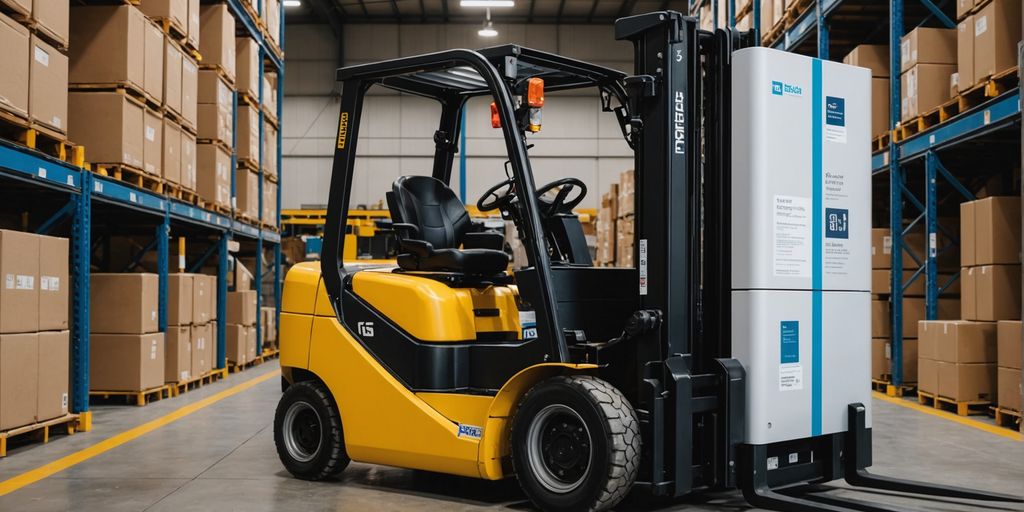Forklift noise in the workplace can be a major issue, leading to stress, hearing problems, and reduced productivity. Thankfully, there are several strategies to help create a quieter environment. This article explores various ways to reduce forklift noise and improve the overall work atmosphere.
Key Takeaways
- Switching to electric forklifts can significantly reduce noise and provide a smoother, quieter operation.
- Regular maintenance of forklifts helps in keeping noise levels down by ensuring all parts are in good working condition.
- Installing noise-reducing tires can lower the sound produced by forklifts, especially on hard surfaces.
- Using sound barriers and absorptive materials in strategic locations can effectively dampen noise.
- Redesigning the workplace layout to create separate noisy and quiet zones can help manage and minimize noise pollution.
Switch to Electric Forklifts
Switching to electric forklifts can significantly reduce workplace noise, creating a more peaceful and productive environment. One difference people immediately notice when switching to electric forklifts is their quietness, smoothness, and low vibration levels. This section explores the benefits, comparisons, and real-world examples of electric forklift implementation.
Implement Regular Maintenance
Regular maintenance is key to keeping forklift noise levels down. Proper upkeep not only extends the life of your equipment but also ensures a quieter workplace.
Key Maintenance Practices
- Lubrication: Regularly lubricate moving parts to reduce friction and noise.
- Inspection: Conduct routine inspections to identify and fix worn or damaged parts.
- Cleaning: Wash your forklifts regularly. Dirt and debris can cause several issues, including increased noise.
Impact of Maintenance on Noise Levels
Proper maintenance can significantly lower noise levels. Machines that are well-maintained are less likely to produce excessive noise due to factors like worn parts or poor lubrication. Increased attention to maintenance can make your equipment quieter and safer to use.
Scheduling and Documentation
- Create a Maintenance Schedule: Plan regular maintenance activities to ensure all forklifts are serviced on time.
- Keep Records: Document all maintenance activities to track the condition of your forklifts and ensure compliance with safety standards.
- Monitor Noise Levels: Regularly check noise levels to ensure they remain within safe limits.
Regular maintenance is not just about keeping your forklifts running; it's about creating a safer and quieter work environment.
Install Noise-Reducing Tires
Types of Noise-Reducing Tires
Noise-reducing tires, such as cushion or solid rubber tires, can significantly lower the noise forklifts produce, especially on hard surfaces. These tires are designed to absorb more sound and vibrations than standard pneumatic tires, making them an effective solution for reducing forklift noise levels. The advanced technology effectively absorbs road noise, reducing by up to 5db, providing a quiet and enjoyable driving experience.
Installation Process
- Choose the Right Tires: Select noise-reducing tires that are compatible with your forklift model.
- Prepare the Forklift: Ensure the forklift is on a stable surface and use proper lifting equipment to raise it.
- Remove Old Tires: Carefully remove the existing tires, following the manufacturer's guidelines.
- Install New Tires: Fit the noise-reducing tires onto the forklift, ensuring they are securely attached.
- Check Tire Pressure: Properly inflate the tires to the recommended pressure to maximize their noise-reducing benefits.
Benefits Beyond Noise Reduction
- Improved Comfort: These tires not only help in reducing noise but also improve the comfort and safety of the forklift operation.
- Enhanced Safety: Properly inflated noise-reducing tires can lead to a quieter and more efficient workplace.
- Longer Lifespan: These tires often have a longer lifespan compared to standard tires, providing better value over time.
By installing noise-reducing tires, you can create a more comfortable and efficient workplace, benefiting both operators and the overall work environment.
Utilize Sound Barriers and Absorptive Materials
Types of Sound Barriers
Sound barriers are essential for blocking the direct path of sound waves. Industrial soundproof curtains are a popular choice, featuring easy hanging grommets and hook-and-loop Velcro attachments. These barriers can be used around noisy machinery like saws and jackhammers to reduce noise levels.
Placement Strategies
Proper placement of sound barriers is crucial. Place barriers close to the noise source to maximize effectiveness. For example, enclosing a loud machine within a barrier can significantly reduce noise exposure for workers.
Material Options and Effectiveness
Different materials offer varying levels of noise reduction. Acoustic foam panels, for instance, can absorb up to 65% of noise. These panels are easy to install and can be mounted on walls and ceilings. Other options include Quiet Barrier® soundproofing sheets, which are lightweight and can be cut to fit specific areas.
Using sound barriers and absorptive materials can create a quieter and more productive work environment. This not only helps in reducing noise but also improves overall workplace safety and comfort.
Redesign Workplace Layout

Creating Noisy and Quiet Zones
Strategic layout planning can greatly reduce noise exposure. By rearranging your workflow to create separate noisy and quiet zones, you can minimize noise pollution in areas where concentration is needed. Place all noisy machinery and operations in one area, while designating other parts as quiet zones. These quiet areas can be used for breaks and tasks requiring higher concentration levels, such as inventory checks or planning.
Optimizing Workflow for Noise Reduction
To further reduce noise, consider optimizing your workflow. This might involve changing the paths that forklifts take or moving certain tasks to different areas. By doing this, you can ensure that noisy activities are kept away from quieter tasks, making the workplace more pleasant for everyone.
Examples of Effective Layouts
Here are some examples of effective layouts:
- Forklift-Free Zones: Establish areas where forklifts are not allowed to reduce noise and increase safety.
- Dedicated Break Areas: Create quiet zones specifically for breaks and relaxation.
- Task-Specific Zones: Designate areas for specific tasks to keep noisy and quiet activities separate.
Redesigning the floor layout and redefining processes can significantly improve safety and reduce forklift accidents. Poor workplace design can lead to increased noise and safety hazards.
By continually assessing and addressing noise levels, you can create a more productive and less stressful workplace for everyone involved.
Provide Hearing Protection

Types of Hearing Protection
There are two main types of hearing protection: ear defenders and earplugs. Ear defenders, also known as earmuffs, fit over the ears and can be attached to safety helmets. They are more comfortable to wear and need to be maintained and replaced when worn or damaged. Earplugs fit inside the ear and can be reusable or disposable. They come in different types to fit various ear shapes and sizes.
Training Workers on Proper Use
Training workers on how to use hearing protection is crucial. Employees should know how to wear it correctly and understand the importance of using it in noisy areas. Training should also cover how to maintain and replace hearing protection when necessary.
Monitoring and Compliance
Ensuring compliance with hearing protection policies is essential. Employers should monitor the use of hearing protection and make sure it is worn in designated areas. Regular checks and health surveillance can help identify any issues early on and ensure that workers are protected from hazardous noise levels.
Invest in Quieter Forklifts
Features of Quieter Forklifts
Modern forklifts come with advanced insulation and quieter engines. These features help in reducing the overall noise levels significantly. Additionally, the use of advanced materials further contributes to a quieter operation.
Cost-Benefit Analysis
Investing in quieter forklifts might seem expensive initially, but the long-term benefits outweigh the costs. Quieter forklifts reduce operator fatigue and improve safety, leading to higher productivity and lower maintenance costs.
| Factor | Electric Forklifts | Diesel Forklifts |
|---|---|---|
| Noise Level | Low | High |
| Maintenance Cost | Low | High |
| Initial Investment | High | Low |
Long-Term Benefits
Quieter forklifts not only create a more peaceful work environment but also contribute to driving sustainability and efficiency. They help in reducing noise pollution, which can lead to better worker concentration and overall productivity.
Investing in quieter forklifts is a smart choice for maintaining a peaceful and productive work environment. The long-term benefits, including reduced operator fatigue and improved safety, make it a worthwhile investment.
Conclusion
Creating a quieter workplace by reducing forklift noise is not just about comfort; it's about safety and productivity too. By switching to electric forklifts, maintaining equipment regularly, and using noise-reducing tires, businesses can significantly lower noise levels. Implementing sound barriers and redesigning workspaces to separate noisy and quiet zones also play a crucial role. These changes help protect workers' hearing, reduce stress, and improve overall communication. Ultimately, a quieter workplace leads to happier, healthier employees and a more efficient operation. Simple steps can make a big difference, ensuring a safer and more pleasant environment for everyone.
Frequently Asked Questions
Why should I switch to electric forklifts?
Electric forklifts are much quieter than diesel ones, reducing noise in the workplace. They also produce less vibration, making them more comfortable for operators.
How does regular maintenance affect forklift noise?
Regular maintenance keeps forklifts running smoothly and quietly. Checking and fixing parts like engines and exhaust systems can prevent them from getting too noisy.
What are noise-reducing tires?
Noise-reducing tires are special tires that absorb more sound and vibrations than regular tires. They help make forklifts quieter, especially on hard surfaces.
How can sound barriers help reduce noise?
Sound barriers block and absorb noise, making the workplace quieter. They can be placed in areas where forklifts operate a lot to reduce overall noise levels.
What is the benefit of redesigning the workplace layout?
Redesigning the layout to create separate noisy and quiet zones can help control noise levels. This makes it easier for workers to concentrate and communicate in quieter areas.
Why is hearing protection important in noisy workplaces?
Hearing protection, like earplugs or earmuffs, helps protect workers from hearing damage caused by loud noises. It's especially important in areas with high noise levels, like those with diesel forklifts.




Leave a comment
This site is protected by hCaptcha and the hCaptcha Privacy Policy and Terms of Service apply.